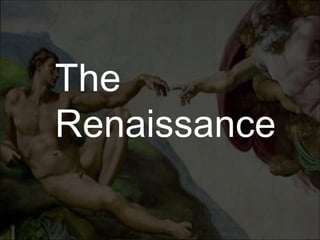
Renaissancepowerpoint 1231360659132490-2
- 2. What was the Renaissance? A period after the Middle Ages. The start of the “modern world” New interest in old stuff, like Greece & Rome Changes in thought about art, religion, literature, education
- 3. Where did the Renaissance Start? Began in Italy Later spread north to Germany and England What was the difference between the Northern and Italian Renaissance…?
- 5. The Italian Renaissance They were interested in human achievement (instead of religious or spiritual achievement) The figures in their artwork looked like Greek or Roman gods, i.e. perfect
- 6. The Northern Renaissance They were interested in the early Christian period. The figures in their artwork were more realistic.
- 7. Both Northern & Italian Renaissance Interested in Greek & Roman culture (“the classics”) Use of perspective in paintings Believed in humanism Used critical method of study
- 8. What’s Humanism? Idea started in the Renaissance that people have value, worth. MA: Only God can do good RA: Humans can do good Liberal arts education (still here today)
- 10. Middle Ages •No perspective •No proportion •Amateur
- 11. Many religious themes. Shows how central religion was.
- 14. Renaissance Everyday scenes. More realistic.
- 16. Leonardo da Vinci The Last Supper 1495-1498 Mona Lisa 1503-1505
- 17. The Vitruvian Man Leonardo da Vinci
- 18. Michelangelo The Creation of Adam, 1511
- 19. Michelangelo David 1501-1504 Pieta 1498-1499
Hinweis der Redaktion
- virtuous, knowledgeable, and articulate person Grammar, Rhetoric and Logic mathematics, geometry, music, and astronomy
- The Last Supper (Italian: Il Cenacolo or L'Ultima Cena ) is a 15th century mural painting in Milan created by Leonardo da Vinci for his patron Duke Ludovico Sforza and his duchess Beatrice d'Este. It represents the scene of The Last Supper from the final days of Jesus as it is told in the Gospel of John 13:21, when Jesus announces that one of his Twelve Disciples would betray him. 1494 1503 The Mona Lisa is a half-length portrait of a woman by the Italian artist Leonardo da Vinci, which has been acclaimed as "the best known, the most visited, the most written about, the most sung about, the most parodied work of art in the world." Lace on Mona Lisa's dress The transparency of the veil shows da Vinci first painted a landscape and then used transparency techniques to paint the veil atop it. A change in the position of the left index and middle finger. The elbow was repaired from damage due to a rock thrown at the painting in 1956. The blanket covering Mona Lisa's knees also covers her stomach. The left finger was not completely finished. A blotch mark on the corner of the eye and chin are varnish accidents, countering claims that Mona Lisa was sick. And the Mona Lisa was painted on uncut poplar board, contrary to speculations.
- The Vitruvian Man is a drawing created by Leonardo da Vinci circa 1487.[1] It is accompanied by notes based on the work of the architect Vitruvius. The drawing, which is in pen and ink on paper, depicts a male figure in two superimposed positions with his arms and legs apart and simultaneously inscribed in a circle and square. The drawing and text are sometimes called the Canon of Proportions or, less often, Proportions of Man . It is stored in the Gallerie dell'Accademia in Venice, Italy, and, like most works on paper, is displayed only occasionally.[2][3] The drawing is based on the correlations of ideal human proportions with geometry described[4] by the ancient Roman architect Vitruvius in Book III of his treatise De Architectura. Vitruvius described the human figure as being the principal source of proportion among the Classical orders of architecture. Leonardo's drawing is traditionally named in honor of the architect. Leonardo was among the first Europeans to read Vitruvius in centuries, after manuscripts preserved in the Islamic world had been translated back into Latin. [5]
- The Creation of Adam is a section of Michelangelo's fresco Sistine Chapel ceiling painted circa 1511. It is traditionally thought to illustrate the Biblical creation narrative from the Book of Genesis in which God breathes life into Adam, the first man. Chronologically the fourth in the series of panels depicting episodes from Genesis on the Sistine ceiling, it was among the last to be completed.
- David is a masterpiece of Renaissance sculpture created between 1501 and 1504, by the Italian artist Michelangelo. It is a 5.17-metre (17.0 ft)[1] marble statue of a standing male nude. The statue represents the Biblical hero David, a favoured subject in the art of Florence.[2] Originally commissioned as one of a series of statues of prophets to be positioned along the roofline of the east end of Florence Cathedral, the statue was instead placed in a public square, outside the Palazzo della Signoria, the seat of civic government in Florence, where it was unveiled on 8 September 1504. The Pietà (1498–1499) is a masterpiece of Renaissance sculpture by Michelangelo Buonarroti, housed in St. Peter's Basilica in Vatican City. It is the first of a number of works of the same theme by the artist. The statue was commissioned for the French cardinal Jean de Billheres, who was a representative in Rome. The sculpture, in Carrara marble, was made for the cardinal's funeral monument, but was moved to its current location, the first chapel on the right as one enters the basilica, in the 18th century. It is the only piece Michelangelo ever signed (See History after completion). This famous work of art depicts the body of Jesus on the lap of his mother Mary after the Crucifixion. The theme is of Northern origin, popular by that time in France but not yet in Italy. Michelangelo's interpretation of the Pietà is unique to the precedents. It is an important work as it balances the Renaissance ideals of classical beauty with naturalism. The statue is one of the most highly finished works by Michelangelo.